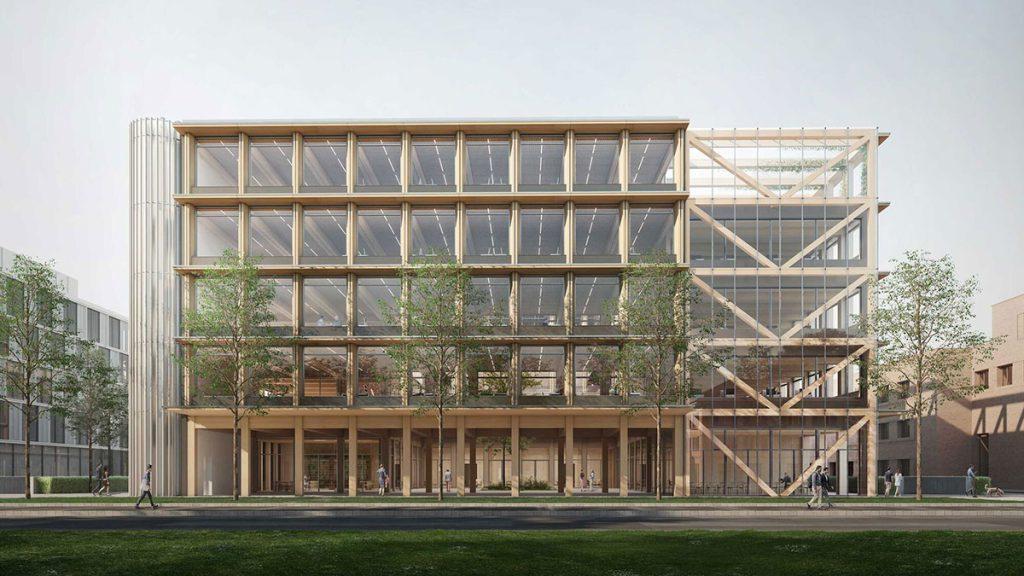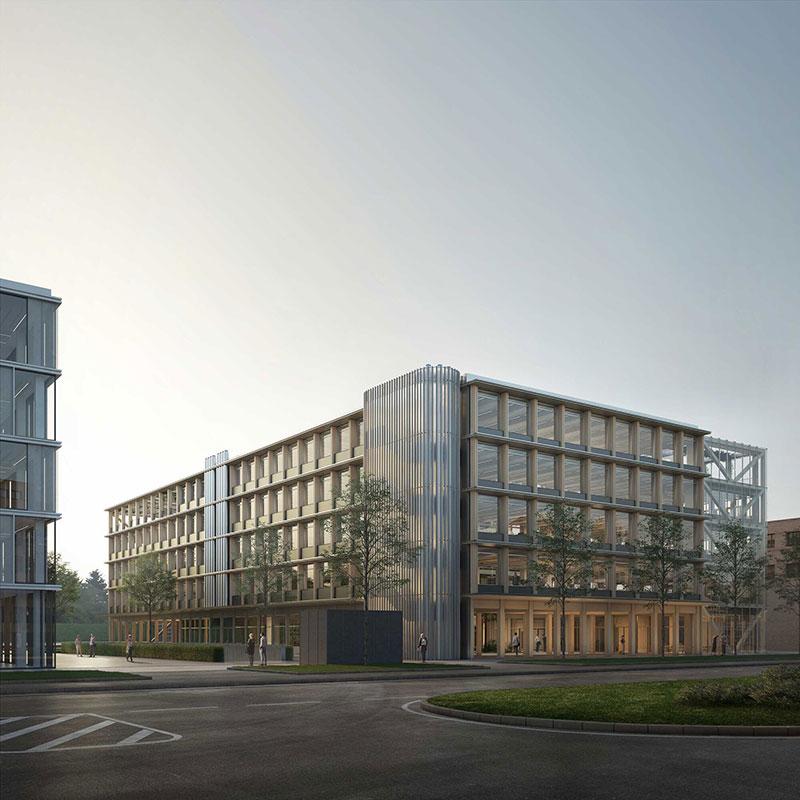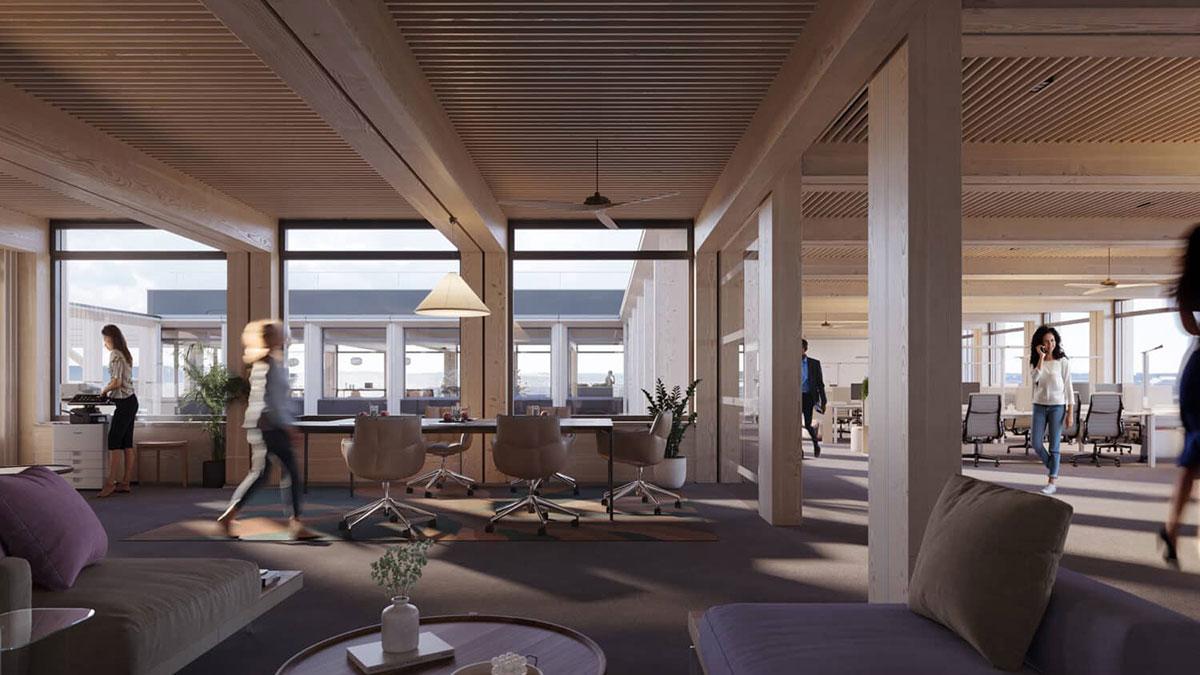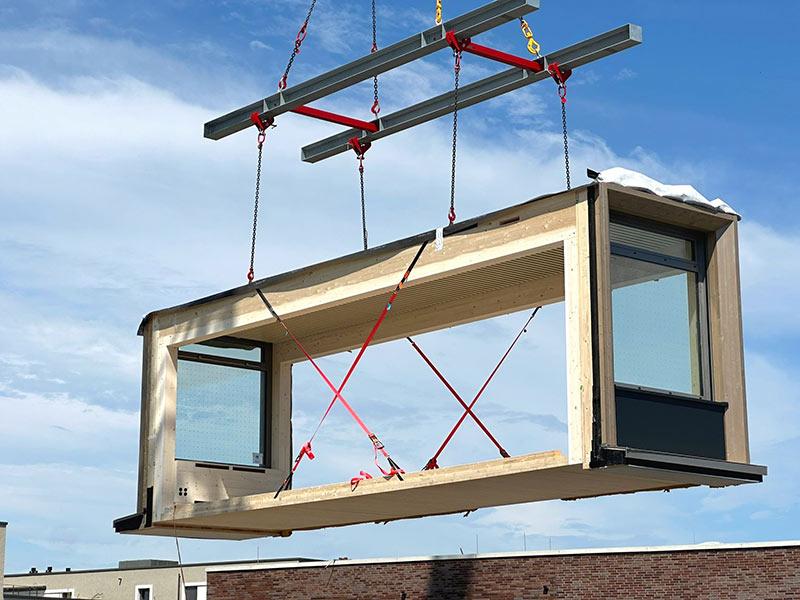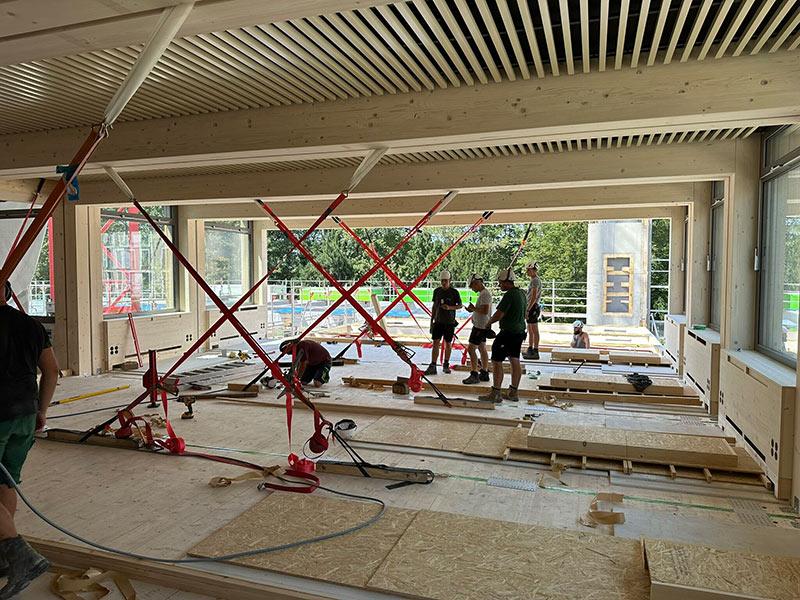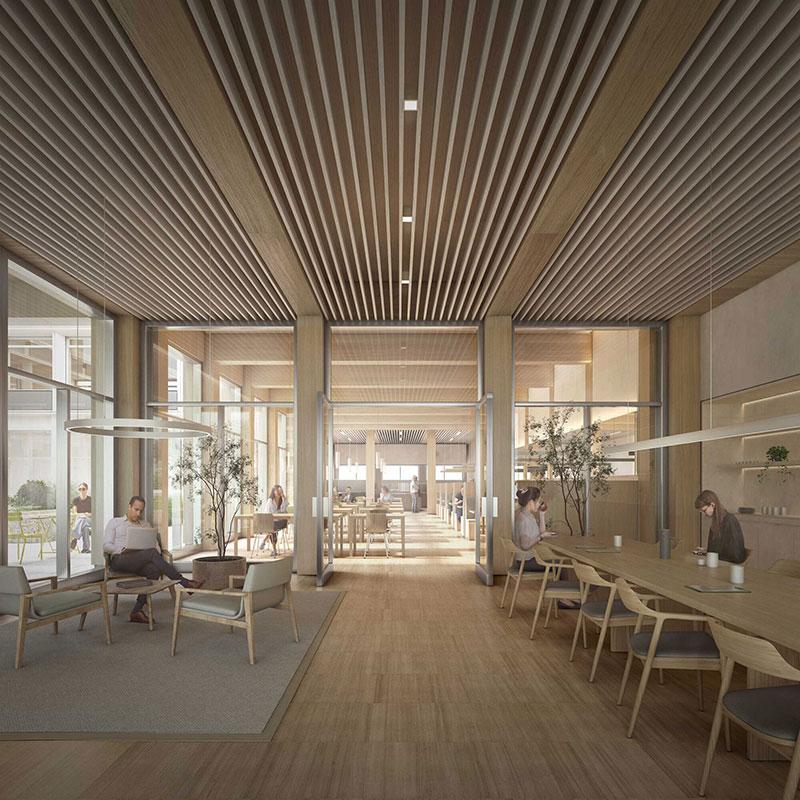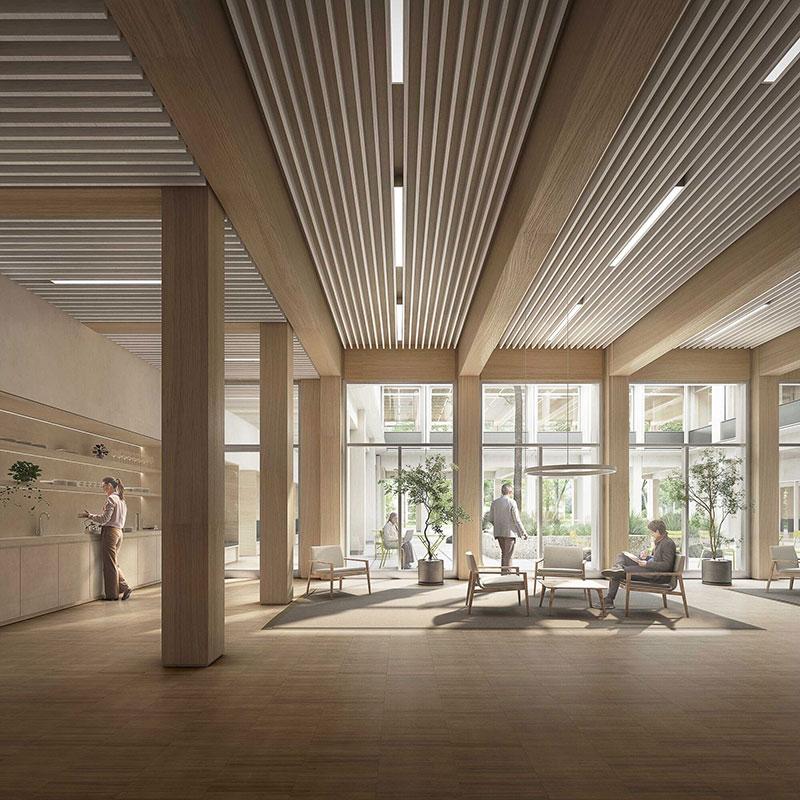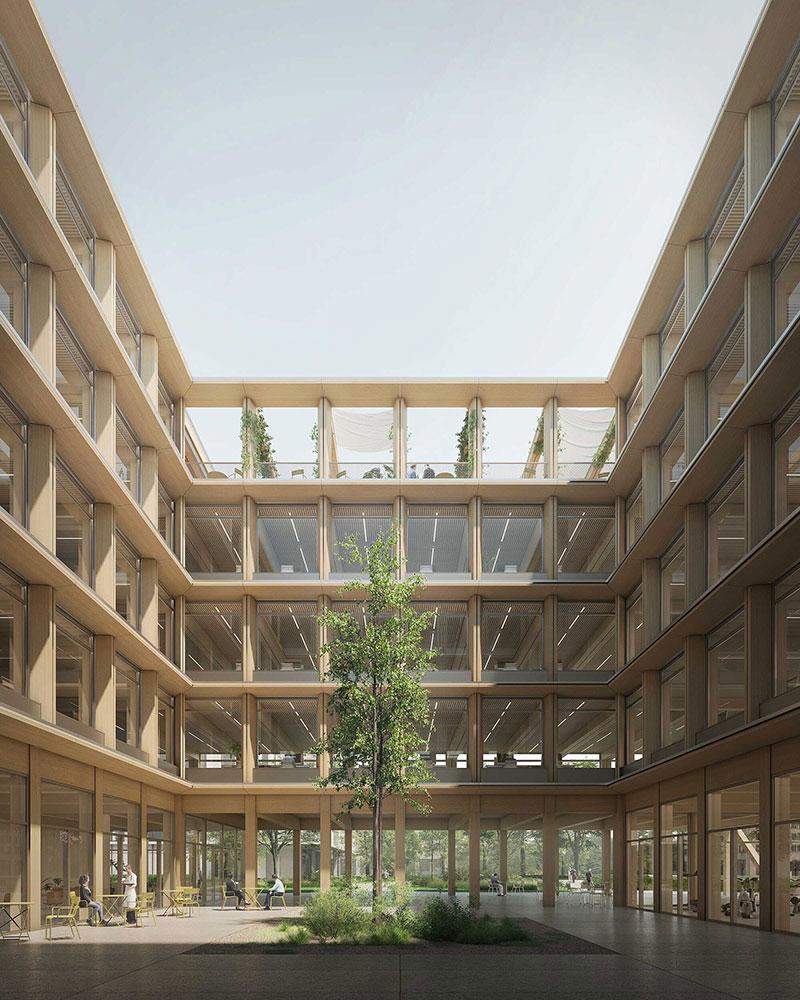Series production for timber offices
ZERO. is a new modular office building in Stuttgart which uses serially manufactured wooden elements and building technology that exploits passive physical effects. This multi-tenant investor project takes a fresh approach in its sharing of spaces and services.
It was an exhilarating moment when the timber modules started arriving at the ZERO. construction site in Stuttgart. On the project account, there were reports of flying objects – although it quickly became clear that these were anything but UFOs. A crane lifted pre-assembled timber modules, complete with windows and holes for connections, directly into the correct position from the HGVs. A team of assembly workers then connected up the 10-metre sections as if they were building an oversized Lego set. On the first day, around 300 square metres of rental area were created for the office building ZERO. in Stuttgart-Möhringen. Offering workspace for over 400 people, it is the first timber building of this size in Stuttgart.
As is the case with all projects that involve a city’s first multi-storey timber construction, a lot of pioneering work was needed to convince the authorities. After all, even though similar projects have already been completed in other cities, regulations such as noise control and fire protection are re-negotiated each time. “Unfortunately, there is still a lack of networking and knowledge sharing in this area,” explains Niklas Humm, the project manager responsible for ZERO. at CPM, which is handling the project and construction management on behalf of developer EEW GmbH.
Off the assembly line
In any case, this trailblazing project on the former Hansa factory site is full of ambition. Their aim is “to overcome the boundaries of conventional construction”, according to the project website. Humm describes this in more detail: “Conventional construction is highly susceptible to errors, and it also makes a lot of dust, noise and waste. Modular timber construction uses serial, controlled processes at production plants. This translates into a huge step forward in the quality of the construction work.” It also shortened the construction time because the majority of the components were pre-assembled at the production plant.
The design for this five-storey office building was created by Stuttgart architects Riehle Koeth. A total of 286 timber modules were produced, in a process involving close-knit teamwork. The concepts and engineering were the responsibility of Vorarlberg-based modular construction specialist Kaufmann Bausysteme. And the modules themselves were built by the Zimmerei Stark in Auhausen on the production line at Baumgarten Holzbau in Ebersdorf. These two partners have joined forces to set up the German modular timber construction company BS Holzmodulbau.
Plenty of visible wood
The timber design for ZERO. is visible on the exterior as well, with conspicuous elements including the slender overhangs on each floor. These also double up as protection for the wood on the facade, which allows these timber parts to remain visible. In comparable projects, the outer shell tends to reveal little about the building method, but in this case it is easily recognizable.
Modular timber construction uses serial, controlled processes at production plants. This translates into a huge step forward in the quality of the construction work.
Niklas Humm, CPM project manager
The individual modules are grouped around two greened courtyards, which lets a lot of natural daylight inside the workspace. There is also plenty of wood visible in the interior. Columns and beams are made of glulam timber, while the slatted ceiling originally had a timber design but had to be made of aluminium for fire safety reasons.
“Non-flammable panelling” has become a trigger for project manager Niklas Humm. In practice, not much wood can be seen inside buildings when all fire safety regulations have been fulfilled. ZERO. is his first timber construction project, and it has inspired a passion for this natural building material. “The wood makes you stop and think, it has such an impressive effect on everyone.”
Shared use of space
As far as actual usage is concerned, the project is based on an efficient system that is rather unusual for a multi-tenant investor project. In future, the ground floor will be used and operated by all office tenants on a mutual basis. Conference rooms, canteen, café, and also sports and fitness areas – amounting to approx. 15 percent of the total space – are available to everyone who works here.
Shared use of space increases capacity utilization and strengthens the community, which satisfies the social dimension of ESG.
Niklas Humm, CPM project manager
This is a highly challenging undertaking with regard to its planning and business decisions, as Humm admits. However, the advantages for its users outweigh any difficulties. “Shared use of space increases its capacity utilization while saving resources and operating costs. Besides this, it strengthens the community, which satisfies the social dimension of ESG.”
Natural ventilation system
The aluminium pipes extending conspicuously from bottom to top give the building its own kind of Centre Pompidou aura. These are actually the central exhaust air stacks that are partly solar-operated. “The solar stacks on the façade illustrate the energy-saving ventilation concept, and this should be visible from the outside as well,” explains Humm.
The solar stacks on the facade illustrate the energy-saving ventilation concept.
Niklas Humm, CPM project manager
To save energy, the top floors were designed without a mechanical ventilation system. Instead, a natural air supply for these areas was linked to the use of passive physical effects.
The basic principle is easily explained: the difference in pressure and temperature between the inside and outside air creates a natural stack effect that allows the air to rise. As fresh air flows in, it is preconditioned by convectors before being distributed through the rooms. The warmth and cold are supplied by a 400 m³ ice storage tank.
Progress through less technology
The term that springs to mind here – admittedly one disliked by developers – is “low-tech”, mainly because such ventilation was already around thousands of years ago. Solar chimneys have a very long tradition in the Middle East. Moreover, they are currently becoming increasingly popular in contemporary architecture as they run on very little electricity, unlike air conditioning and mechanical ventilation systems. This also avoids any harmful emissions. And so it is definitely progress as long as the technology is omitted in the right places.
Standardized, serial production means that this modular timber office building has literally come off the assembly line. Humm is unable to say if there will be other standardized buildings in the near future, but he is already convinced of its benefits: “ZERO. Stuttgart is basically the start of what’s to come. This is a pilot project for us, and we intend to continue developing our findings.”
Text: Gertraud Gerst
Translation: Rosemary Bridger-Lippe
Photos: CPM
Visualizations: Filippo Bolognese Images
